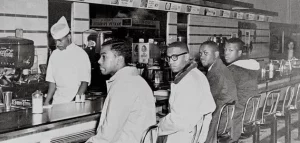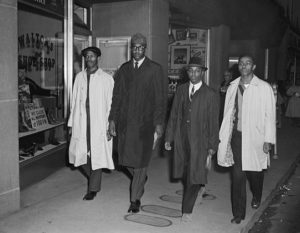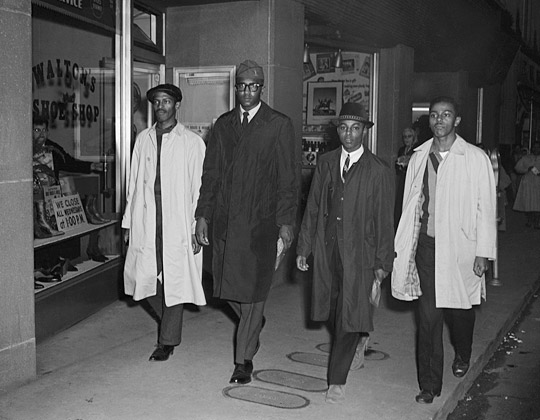

The Greensboro Four is an example of history not taught in schools. The Greensboro Four consisted of Ezell Blair Jr., David Richmond, Franklin McCain and Joseph McNeil. These young men were students at North Carolina Agricultural and Technical College (NC A&T). They wanted to partake in a peaceful protest because they were influenced by the nonviolent movement of Mohandas Karamchand Gandhi and the Freedom Rides that were organized by the Congress of Racial Equality to promote equality while traveling on interstate bus systems.
The four students were also inspired to advocate for civil rights due to the recent (at the time in 1955) brutal murder of Emmett Till. The Woolworth sit-in took many months of planning and organization and it was also a collaborative effort, because women students from Bennett College helped with the planning.
The women who participated with the Greensboro Four were known as the Bennett Belles and served as a collective lookout for the men while they sat during their protest. The Black community in Greensboro was united for this cause because they all felt the struggle that accompanied segregation. McNeil was compelled to organize the event after going to a diner in New York on a trip in 1959. New York did not have Jim Crow laws in place, so he was able to eat in peace without being separated from anyone due to his skin color.
On February 1, 1960, the young men took seats at Woolworth diner in Greensboro, NC. They were denied service, but they refused to leave their seats. The police and local media were called. The police were unable to do much to detain the college students because they were not threats to anyone; they simply demanded to be treated equally.
Due to media coverage, 300 additional people joined the movement. It drew counter-protesters, including the Ku Klux Klan, who wanted to intimidate the protestors and force them to retreat. However, their efforts did not deter the protestors. The sit-in sparked similar movements in 55 other cities. The movement also made it known that young people were key forces driving the civil rights movement.


This particular sit-in drew national attention, and the protest spread to hotels, beaches, libraries. After many months, on July 25, 1960, the Woolworth lunch counter allowed integration. Furthermore, the sit-ins encouraged the creation of the Student Nonviolent Coordinating Committee in Raleigh. The SNCC would later invite Dr. Martin Luther King, Jr. to work with them to integrate the eatery in Rich’s Department Store in Atlanta, Georgia in 1960.
The SNCC participated in the Freedom Rides (1961), the Freedom Summer Effort (1963), and members helped the NAACP get the 1964 Civil Rights Act passed by Congress. Eventually, the SNCC was disbanded because as it grew more powerful, supporters faced more violent counterattacks. In retaliation, they were militant and focused on the phrase “black power.” Champions they once had withdrew causing the organization’s demise. Despite this, they had a good run and helped to advance the civil rights movement.
Some of the aspects that were eye-opening about this sit-in was that this time period was not eons ago – 1960 was just 62 years ago. It’s insane that within someone’s lifetime, the American people were segregated. I was shocked I never learned about this in school even though this took place within the state of North Carolina where I grew up.
One would think this story would be shared over and over. It’s almost as if the schools are content teaching students a little bit about Martin Luther King Jr. and Rosa Parks and believe that is sufficient enough to say that Black History was a part of their curriculum. School systems must do better!
I wish I knew about the Greensboro Four during my middle and high school years. However, I am glad I learned about them through my research because their story is one that not only inspires, but it also exhibits the resiliency of Black people. I can only imagine what hateful speech, physical attacks, and other aggression they faced from counter-protesters. However, the four young men and the Bennett Belles did not back down. My takeaway from this is to keep pressing and keep using my platform and voice to speak out against injustice. Despite having many victories in the fight against racism, there is still much work to do and the fight is not over.
 Jasmin Ikard resides in the RDU area.
Jasmin Ikard resides in the RDU area.

There are no comments
Add yours